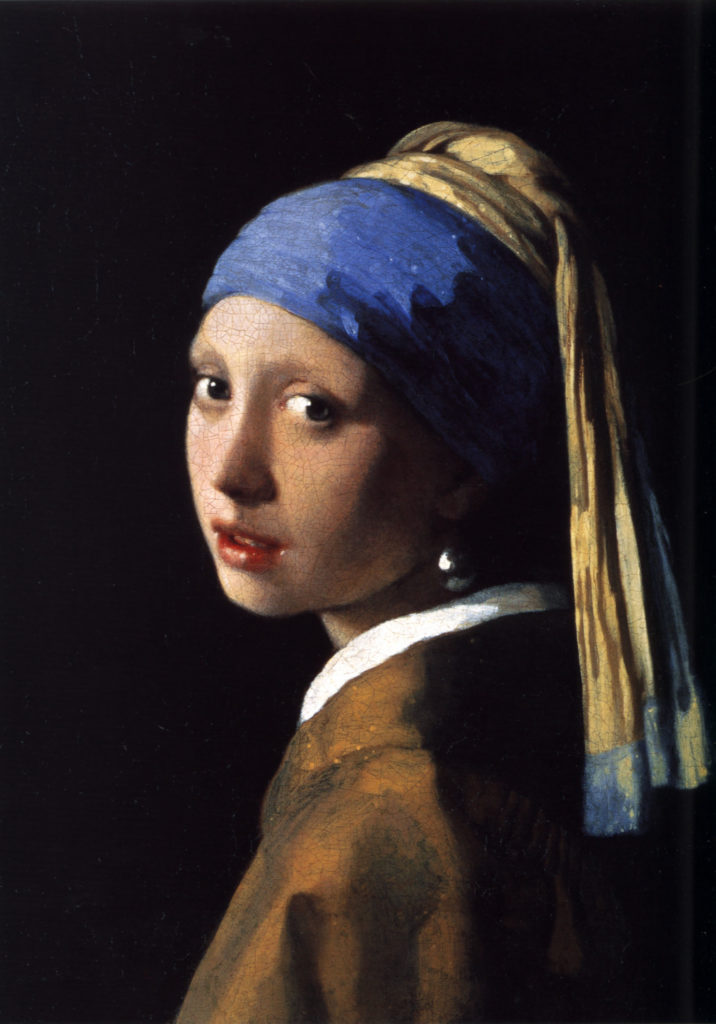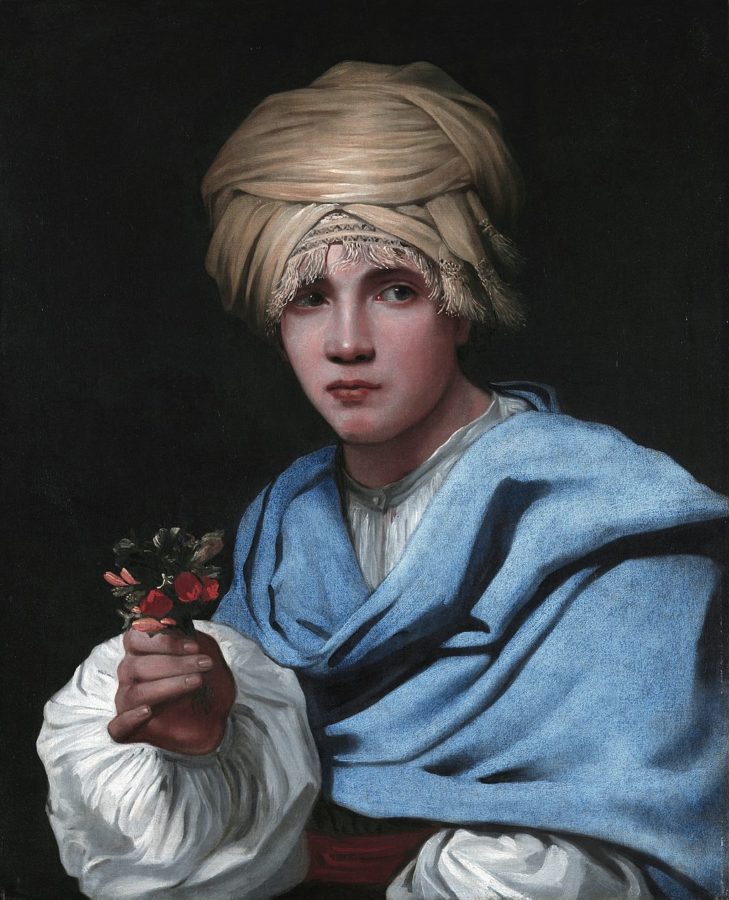When Was The Girl With The Pearl Earring Painted
The Girl with a Pearl Earring is usually the first image that comes to mind when we recollect of Johannes Vermeer. It has inspired multiple references in literature, cinema, and popular civilisation. Perhaps many of you remember it from the homonymous novel by Tracy Chevalier or from the movie in which Scarlett Johansson plays the leading function. Along with Rembrandt'due south The Nighttime Spotter and van Gogh'south self-portraits, it has become an artistic icon of the netherlands. More than three centuries after it was painted, the Girl with a Pearl Earring continues to captivate our eyes and minds. In this article we provide some essential facts about this painting and reflect on what makes it a masterpiece.

Johannes Vermeer was a Dutch painter born in Delft in 1632 and deceased in the aforementioned city in 1675. He painted the Girl with a Pearl Earring around 1665 (scholarly estimations range betwixt the years 1665 and 1667). Therefore, the painting corresponds to the Dutch Golden Age, a period of economic, scientific, and artistic prosperity spanning virtually the entire 17th century. At that time, The netherlands was part of the Dutch Republic, a prominent maritime ability made upwards of seven Calvinist provinces that had seceded from the Spanish Empire as a result of The Lxxx Years' War. Along with Amsterdam, Haarlem, Leiden, and Utrecht, Delft was one of the principal artistic centers in Holland.
The Girl with a Pearl Earring is a tronie that represents a young woman wearing a turban and an exceptionally large pearl earring. A tronie is a blazon of painting which represents a person but differs from a portrait. In a portrait, the emphasis falls on the sitter. The portrait reflects the sitter's features and, although it may contain accessories or allegorical elements, the sitter must remain identifiable. In a tronie, the emphasis shifts to the painter. It is the painter who must be identifiable. Tronies give painters the opportunity to condense the all-time of their technique into a single piece of work. They showcase what a particular painter is capable of producing, frequently by including challenging elements such as exaggerated facial expressions or exotic clothing and accessories.
In the case of the Girl with a Pearl Earring, clothing and accessories are fundamental. Here, we explicate why: The hierarchy of pictorial genres in the 17th century was rooted in Neo-Platonism, a school of idea which considered ideas as superior to nature. Therefore, paintings that resulted from a groovy mental try ("major genres" such as representations of mythology, classical literature or the Bible) were considered superior to the ones that reproduced images equally the painter saw them ("pocket-sized genres" such as portraits, landscapes, all the same lifes, etc.). In practice, this hierarchy was applied flexibly in holland. Paintings of daily life scenes and fifty-fifty of vulgar environments such as taverns and brothels were mutual during the Dutch Golden Age.
Simply, for a painting of a small genre to be admired as a masterpiece, skill and meticulousness were not enough. The painting had to comply with the rules of elegance and decorum. Neo-Platonism held that the purpose of painting was not just to imitate nature, but to surpass it. Therefore, it was non enough to stand for a scene realistically or with many details. It was necessary to idealize it, to movement it away from the mundane and elevate it to a college condition. Even if the subject of a painting was a scene of daily life, information technology had to exist invested with "classical dignity." Article of clothing and accessories helped reach that goal. Elements of paintings that have been later identified as "Oriental", "Turkish" or "Slavic" do not actually refer to a national or ethnic origin. Instead, they indicate that the represented characters take been taken abroad from their particular spatial and temporal contexts and placed in the superior realm of the ideal.
The Girl with a Pearl Earring is an ideal case. The character of a young adult female with European features has undergone idealization through the apply of exotic wearable and accessories such as the turban, which evokes oriental beauty, and the pearl, which reminds of the riches that came to Europe through international maritime trade. The outcome of this procedure of idealization is that the Girl with a Pearl Earring is no longer a Dutch girl or a 17th-century girl. She is a timeless and universal Girl. Being a sort of abstruse platonic, borders of space and time disappear between her and u.s..
A similar use of apparel was washed by other Dutch Aureate Historic period painters. We encounter beneath 2 examples, one past Rembrandt and the other by Michael Sweerts, a painter who worked in Amsterdam and shared with Vermeer the aspiration of providing classical nobility to daily life scenes.


It was usual for Vermeer to place some kind of barrier betwixt the women in his paintings and the viewer, such as a curtain or a piece of furniture (see for case the Lady Writing a Letter with her Maid). But in The Daughter with a Pearl Earring this is non the example. Additionally, the small size of the canvass and the dark monochrome background assistance create a pleasant temper of intimacy with the Girl. Null distracts our attention from her. We see her directly equally if she were a living woman turning her face up to united states of america when nosotros call her.
Timeless, universal and incredibly close to us, the Girl with a Pearl Earring is a captivating masterpiece.
To find out more virtually Vermeer'southward paintings, see the commodity on The Milkmaid and the piece on Young Woman with a Water Bullpen.
Works Cited
- BLANKERT, A. (1996) Vermeer'south Modern Themes and Their Tradition. In WHEELOCK, A. Thou. (ed.) Johannes Vermeer. Exhibition Itemize. Washington, National Gallery of Fine art, from 12-Eleven-1995 to 11-2-1996 and The Hague, Royal Chiffonier of Paintings Mauritshuis, from 1-Iii-1996 to 2-VI-1996.
- CASSEGRAIN, G. et al. (1996) Fifty'ABCdaire de Vermeer. Paris: Flammarion.
- GORDENKER, Eastward. (1999) «The Rhetoric of Apparel in Seventeenth-Century Dutch and Flemish Portraiture» The Periodical of the Walters Fine art Gallery. Vol. 57, p. 87-104.
- JANSON, J. (2019a) "Daughter with a Pearl Earring" In The Consummate Interactive Vermeer Catalogue
- JANSON, J. (2019b) "Tronien" In Vermeer'southward Painting in the Context of the Dutch Golden Age of Painting.
- WHEELOCK, A. K. (ed.) (1996) Johannes Vermeer. Exhibition Itemize. Washington, National Gallery of Fine art, from 12-11-1995 to 11-Ii-1996 and The Hague, Imperial Cabinet of Paintings Mauritshuis, from 1-Iii-1996 to 2-VI-1996.
Source: https://www.dailyartmagazine.com/painting-of-the-week-johannes-vermeer-girl-with-a-pearl-earring/
Posted by: shafferramie1964.blogspot.com

0 Response to "When Was The Girl With The Pearl Earring Painted"
Post a Comment